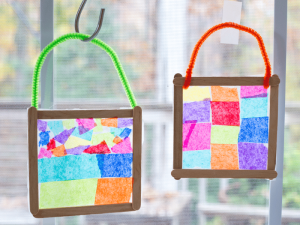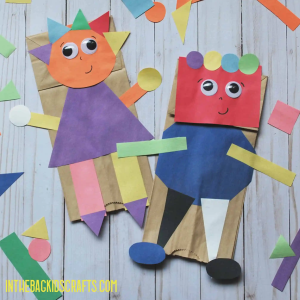Open-ended art activities are a gateway to unlocking a child’s imagination, encouraging them to think outside the box, and embracing their unique ideas.
They provide a canvas for little ones to freely express themselves, explore various materials, and develop their fine motor skills.
We shall now explore fun & easy Open Ended Preschool Art Activities that are sure to captivate your child’s attention and spark their artistic flair.
Nature Collage:

Take your preschoolers on an outdoor adventure to collect a variety of natural materials such as leaves, flowers, twigs, and pebbles. Provide them with a large sheet of paper and some glue. Encourage the children to arrange and stick the natural materials onto the paper, creating their own unique nature collage. Watch as their imagination takes flight, as they explore different colors, shapes, and textures. This activity not only promotes creativity but also connects children with the natural world, fostering an appreciation for the beauty that surrounds them.
Sensory Painting:

Prepare a sensory painting experience by setting up a variety of textured materials such as bubble wrap, sponges, and fabric squares. Pour different colors of paint onto shallow containers. Let the children dip the textured materials into the paint and explore the different sensations as they press them onto a large sheet of paper. This activity stimulates their sense of touch, encourages experimentation, and allows for a multi-sensory art experience. The resulting artwork will be a vibrant and textured masterpiece.
Related: 20 Incredible Games Like Hopscotch
Playdough Sculptures:

Playdough is a versatile and beloved medium for preschoolers. Set up a playdough station with different colors of playdough and various tools such as rolling pins, cookie cutters, and plastic knives. Let the children unleash their creativity by sculpting their own unique creations. They might make animals, food, or even imaginary creatures. This activity not only enhances fine motor skills but also encourages imaginative play and storytelling as children bring their playdough sculptures to life.
Shadow Tracing:

Harness the power of light and shadows in this engaging art activity. Set up a light source, such as a lamp, and position objects with interesting shapes in front of it. Place a sheet of paper on a flat surface and invite the children to trace the shadows cast by the objects using pencils or crayons. This activity encourages observational skills, hand-eye coordination, and the understanding of spatial relationships. The children will delight in capturing the intricate details of the shadows and creating their own shadow-inspired artworks.
Related: 20 Playful Fall Themed Games for Preschoolers
Recycled Art:

Encourage sustainability and creativity by engaging preschoolers in a recycled art project. Collect a variety of recyclable materials such as cardboard boxes, plastic bottles, and egg cartons. Provide child-safe scissors, glue, and a range of art supplies like markers, paint, and colored paper. Let the children transform these materials into new and exciting artworks. They can create robots from boxes, flowers from egg cartons, or use plastic bottles as paintbrushes. This activity not only nurtures creativity and resourcefulness but also teaches children the value of repurposing materials to reduce waste.
Bubble Wrap Printing:

Unleash the excitement of bubble wrap in a unique printing activity. Cut small squares of bubble wrap and place them flat on a table. Squeeze different colors of paint onto shallow plates or trays. Invite the children to dip the bubble wrap into the paint and then press it onto the paper. As they press down, they’ll witness the bubbles leave behind colorful prints. Encourage experimentation with different colors and patterns. This activity not only introduces children to printmaking techniques but also provides a sensory experience as they pop the bubbles and create their own textured masterpieces.
Related: 100 Funny Lego Jokes for Kids of All Ages
Shape Collage:

Introduce shapes in a fun and creative way with a shape collage activity. Cut out various shapes, such as circles, squares, triangles, and rectangles, from colorful paper. Provide a large sheet of paper and a glue stick. Let the children arrange and glue the shapes onto the paper to create their own unique collages. Encourage them to explore different arrangements, overlapping shapes, and creating patterns. This activity promotes shape recognition, spatial awareness, and the development of fine motor skills.
Tissue Paper Stained Glass:

Bring vibrant colors and light into the art space with a tissue paper stained glass project. Cut out various shapes from black construction paper or cardstock, creating a frame-like design. Attach a clear plastic sheet or contact paper to the back of the frame. Cut or tear small pieces of colored tissue paper. Invite the children to arrange and stick the tissue paper onto the plastic sheet, creating a beautiful stained glass effect. Hang their creations in the window, and watch as the sunlight filters through, casting a colorful glow. This activity not only explores color and transparency but also introduces children to the concept of light and shadow.
Yarn Painting:

Unleash creativity and texture with yarn painting. Set up a large sheet of paper or cardboard. Provide liquid glue and a variety of colorful yarns. Encourage the children to dip the yarn into the glue and then press it onto the paper, creating abstract designs, shapes, or even letters. They can experiment with different lengths and thicknesses of yarn, creating unique textures and patterns. This activity enhances fine motor skills, and hand-eye coordination, and introduces children to the concept of different art mediums.
Playful Patterns:

Introduce patterns and designs with playful pattern activities. Provide pattern blocks, colorful paper, markers, and glue sticks. Let the children explore creating their own patterns by arranging the blocks on the paper or by drawing patterns using markers. They can also use the pattern blocks to create unique designs and pictures. Encourage them to share their patterns with others and discuss the different ways patterns can be created. This activity enhances critical thinking, mathematical concepts, and artistic exploration.
Nature Weaving:

Take advantage of the beauty of nature by engaging children in a nature weaving activity. Collect sticks or twigs of various lengths and thicknesses. Create notches at the ends of two parallel sticks, forming a rectangular or square frame. Provide children with natural materials like leaves, grass, feathers, and ribbons. Encourage them to weave these materials through the gaps between the sticks, creating a nature-inspired weaving. This activity promotes fine motor skills, introduces children to basic weaving techniques, and allows them to appreciate the textures and colors of natural materials.
Marble Painting:

Get ready for a fun and exciting painting experience with marbles. Place a sheet of paper inside a shallow box or tray. Squeeze small amounts of paint in different colors onto the paper. Drop a few marbles into the box and encourage the children to tilt and rotate the box, causing the marbles to roll through the paint and create colorful tracks on the paper. They can experiment with different movements and angles to produce unique patterns. This activity enhances hand-eye coordination, and fine motor skills, and introduces children to cause and effect relationships.
Paper Bag Puppets:

Combine art and imaginative play by creating paper bag puppets. Provide paper bags, markers, colored paper, googly eyes, and craft materials. Let the children decorate the paper bags by drawing faces, adding features like ears or antennae, and gluing on different materials to create characters. Encourage them to engage in storytelling and put on puppet shows using their creations. This activity nurtures creativity, fosters storytelling skills, and provides a platform for self-expression and dramatic play.
Spin Art:

Turn art-making into a whirlwind of excitement with spin art. Secure a paper plate or cardstock to a spinning device such as a lazy Susan or an electric fan. Drip or splatter paint onto the spinning surface, allowing the centrifugal force to spread and mix the colors, creating unique spin art designs. Children can experiment with different color combinations, control the amount of paint, and observe the patterns that emerge. This activity stimulates curiosity, introduces children to the concept of motion and forces, and produces fascinating and vibrant artworks.
Free Drawing:

Sometimes, the most open-ended art activity is simply providing children with paper and drawing materials. Set up a designated art area with a variety of drawing tools such as crayons, markers, colored pencils, and pastels. Encourage children to let their imaginations run wild and draw whatever comes to mind. Offer prompts or themes for inspiration, but ultimately allow them to explore their own ideas and create freely. This activity promotes self-expression, and fine motor skills, and encourages children to trust their own creative instincts.
Salt Dough Creations:

Engage preschoolers in a hands-on activity by making salt dough and creating unique sculptures. Mix together 2 cups of all-purpose flour, 1 cup of salt, and 1 cup of water to form a dough. Provide the children with the salt dough and let their imaginations guide them as they shape and mold the dough into various objects, such as animals, flowers, or their favorite characters. Once the sculptures are complete, let them air dry or bake them in the oven according to the dough recipe. After they have dried, children can paint their creations to add color and personality to their salt dough masterpieces.
Texture Rubbings:

Introduce children to the world of textures through texture rubbings. Collect objects with different textures, such as leaves, coins, or textured fabric. Place a sheet of paper over the object and encourage children to use crayons or pencils to rub over the paper, revealing the textures underneath. They can experiment with different pressures and angles to capture the details of each texture. This activity not only develops observational skills but also encourages children to explore the tactile qualities of different surfaces and materials.
Music and Movement Painting:

Combine art, music, and movement in a dynamic painting experience. Set up a large canvas or a sheet of paper on the floor. Provide children with various painting tools, such as brushes, sponges, or even their hands and feet. Play different types of music and invite children to respond to the music through their movements and painting. They can dance, jump, or twirl while applying paint to the canvas, creating expressive and vibrant artwork. This activity stimulates creativity, enhances gross motor skills, and allows children to explore the connection between art and music.
Collage Sculptures:

Encourage three-dimensional creativity with collage sculptures. Provide children with a variety of materials, such as cardboard tubes, paper scraps, fabric, buttons, and pipe cleaners. Let them explore and experiment with combining these materials to create their own unique sculptures. They can use glue or tape to secure the pieces together and transform ordinary materials into imaginative and colorful artworks. This activity promotes spatial awareness, and fine motor skills, and encourages children to think in three dimensions.
Edible Art:

Combine creativity and a tasty treat with edible art. Provide children with a selection of edible materials such as fruits, vegetables, bread, cheese, and spreads like peanut butter or cream cheese. Let them use edible materials to create their own artwork or designs on a plate. They can arrange slices of fruit to form colorful patterns or use spreads to draw pictures. This activity not only stimulates creativity and fine motor skills but also introduces children to healthy food choices and encourages them to explore different tastes and textures.

